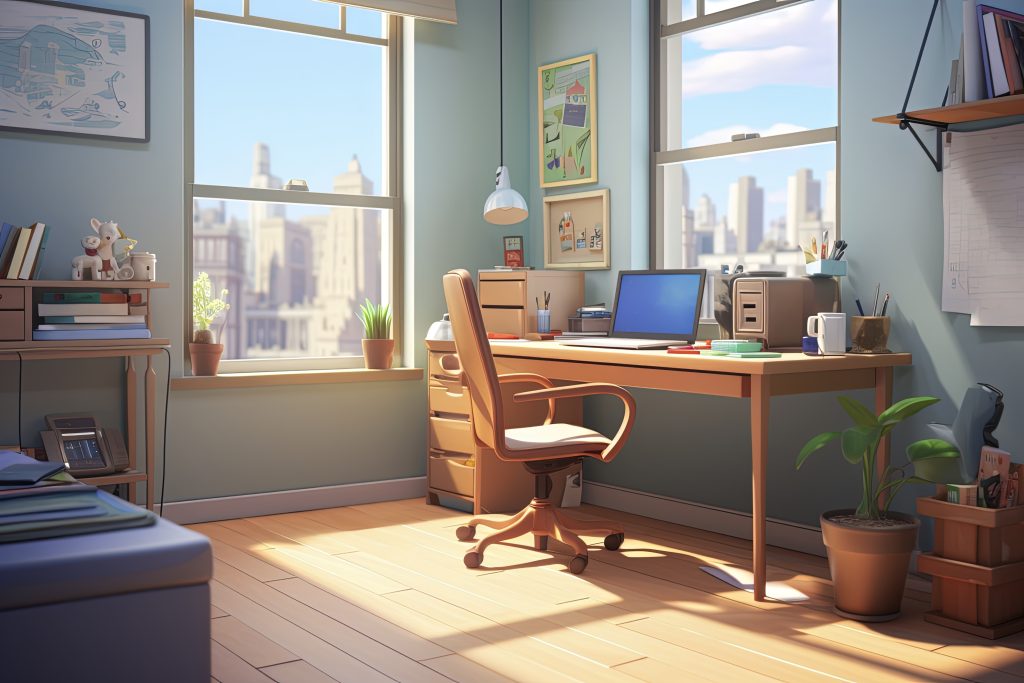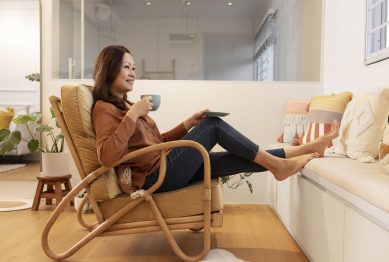As remote work becomes a permanent fixture for many employees and business owners, building a comfortable and productive home office has never been more important. However, creating an ideal workspace doesn’t need to be expensive. In fact, with a little creativity, strategic planning, and a focus on functionality, you can set up a comfortable home office without breaking the bank.
In this article, we’ll explore the current trends in home office setups, provide cost-effective tips for building a functional workspace, and share ideas for creating a space that will enhance both your productivity and well-being.

The Growing Trend of Home Offices
The rise of remote work isn’t a passing trend—it’s here to stay. According to a 2023 study by Gallup, 45% of full-time employees in the U.S. work remotely at least part of the time, and many businesses are embracing hybrid work models. As remote work becomes a long-term arrangement, the demand for comfortable, efficient home offices has surged. However, the idea of a lavish, expensive home office isn’t practical for most people, especially when working within a budget.
The challenge now is to build an office that supports your work needs while still being affordable. Creating a comfortable space doesn’t require purchasing high-end furniture or the latest tech gadgets. Instead, it’s about finding affordable solutions that enhance functionality, comfort, and aesthetics—without compromising on quality or productivity.
The Key Elements of a Comfortable Home Office
Before we delve into budget-friendly ideas, it’s essential to understand the key elements that contribute to a productive and comfortable home office. These elements focus on creating an environment that promotes focus, minimizes distractions, and supports both physical and mental well-being.
1. Ergonomic Comfort
The key to a comfortable home office is ergonomics. Poor posture from sitting at a desk for long periods can lead to back pain, eye strain, and other health issues. Ergonomic furniture, like chairs and desks that support proper posture, can prevent these problems and increase your comfort and productivity.
2. Adequate Lighting
Proper lighting is crucial for reducing eye strain and maintaining energy levels throughout the day. Natural light is ideal, but you can also use affordable desk lamps or floor lamps with adjustable brightness to create a comfortable ambiance.
3. Storage Solutions
A cluttered workspace can lead to distractions and reduced productivity. Having enough storage space for office supplies, papers, and equipment is vital to maintaining an organized and efficient workspace. Smart storage solutions can keep your office tidy without taking up too much space or costing a fortune.
4. Personalized Aesthetics
While functionality is key, aesthetics also play a role in creating a pleasant workspace. A clean and inviting space can boost your mood, making it easier to stay motivated throughout the day. Adding a few personal touches, like artwork, plants, or decorative items, can make the space feel more enjoyable without costing much.
Cost-Effective Tips for Building a Comfortable Home Office
Now that we’ve established the essential elements of a great home office, let’s explore some practical, affordable ways to achieve each of these goals.
1. Invest in a Good Chair (Without Breaking the Bank)
An ergonomic chair doesn’t need to come with a hefty price tag. While high-end ergonomic chairs can cost hundreds of dollars, there are budget-friendly options that still offer great support. Look for chairs with adjustable heights, lumbar support, and a comfortable cushion.
- Tip: Consider buying a used or refurbished chair. Many online marketplaces offer high-quality office chairs at a fraction of the retail price.
2. DIY Desk Solutions
Desks can be expensive, but you don’t need to spend a lot to create a functional workspace. Look for budget-friendly options like folding tables or second-hand furniture. If you’re handy, consider building your own desk with inexpensive materials from local hardware stores or even repurposing old furniture.
- Tip: If you have an old table or desk at home, try sanding it down and giving it a fresh coat of paint to make it feel new and personalized.
3. Maximize Natural Light
Natural light can boost mood and productivity, and it’s free! Position your desk near a window to take advantage of the daylight. If you’re working in a space without much natural light, consider adding a daylight-simulating lamp. These are available for as low as $20 and can help mimic natural light, preventing eye strain and fatigue.
- Tip: Use light-colored curtains or blinds to maximize the amount of light entering the room without compromising privacy.
4. Use Affordable Storage Solutions
Keeping your home office organized doesn’t require expensive storage units. Instead, opt for affordable options like bookshelf units, storage bins, or filing cabinets. You can find affordable storage solutions at IKEA, Target, or online retailers like Amazon.
- Tip: Use vertical space for storage by adding floating shelves above your desk. This allows you to store books or office supplies without taking up additional floor space.
5. Personalize Your Workspace
Making your home office feel inviting doesn’t mean spending a lot on décor. Instead, focus on adding personal touches that inspire you. A few inexpensive items, such as a small indoor plant, a framed print, or a motivational quote, can enhance the ambiance of the room.
- Tip: Look for affordable art prints online or visit local thrift stores for hidden gems that will add personality to your workspace.
6. Utilize Technology to Your Advantage
While technology can become a significant expense, there are affordable tools that can improve your home office setup without the high price tag. For example, a quality external keyboard and mouse can improve ergonomics, and affordable noise-canceling headphones can help you stay focused if you work in a noisy environment.
- Tip: Look for refurbished or budget-friendly tech options. Many online retailers, including Best Buy and Amazon, offer discounted refurbished tech gadgets that still come with warranties.
7. Create a Separate Work Zone
One of the biggest challenges in maintaining a balanced work-life dynamic in a home office is the lack of separation between work and leisure areas. To create that separation on a budget, simply designate a corner or a small area of your home for your workspace. Even if you don’t have a dedicated room, you can create a separate, focused zone.
- Tip: Use room dividers or curtains to create a physical boundary between your workspace and living areas.
The Importance of Routine and Mindfulness in Your Home Office
While creating a comfortable home office is essential for success, building a routine around your workspace is equally important. A productive home office environment goes beyond the physical setup—it involves creating habits that foster focus, creativity, and well-being.
1. Set Clear Boundaries
Establishing boundaries between work and personal life is crucial when working from home. This not only helps with work-life balance but also allows you to maintain mental clarity and avoid burnout. Set working hours and be clear with family or housemates about when you’re available and when you need uninterrupted time.
2. Incorporate Mindfulness Practices
Taking short breaks throughout the day to practice mindfulness or simple stretching can help recharge your mind and body. Regular breaks reduce mental fatigue and enhance focus, making you more productive in the long run.
- Tip: Use a timer to remind you to take 5-10 minute breaks every hour.
3. Create a Productive Routine
A solid routine helps you stay on track and ensures you’re consistently working towards your goals. Start your day with a few minutes of planning, prioritize tasks, and make sure to schedule time for breaks and self-care.
- Tip: Use digital tools like Trello or Asana to organize your tasks and stay accountable.
Conclusion
Building a home office on a budget is possible, even if you’re looking for high-quality materials and a comfortable workspace. With some creativity, strategic purchases, and smart organization, you can create an environment that fosters productivity and promotes well-being. Prioritize ergonomics, lighting, storage, and personalization, and you’ll soon have a home office that meets both your professional needs and personal style—without the hefty price tag.
By focusing on the essentials and finding budget-friendly alternatives, you can create a home office that sets you up for success, day in and day out.
Reference
- Budget Home Office Ideas That Look Expensive, https://www.thespruce.com
- Home Office Furniture, https://www.worldmarket.com
- Enlightening Your Workspace: https://www.homzi.com









